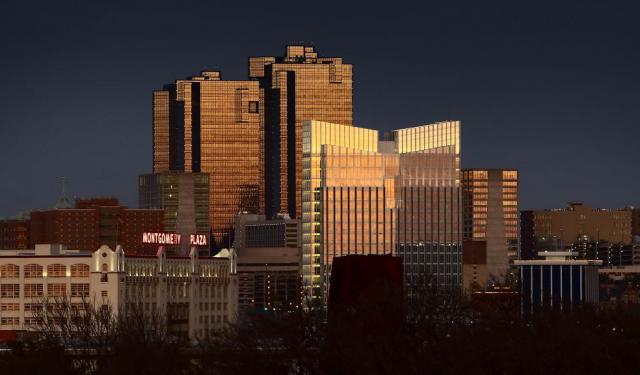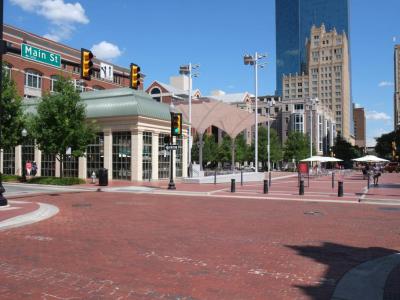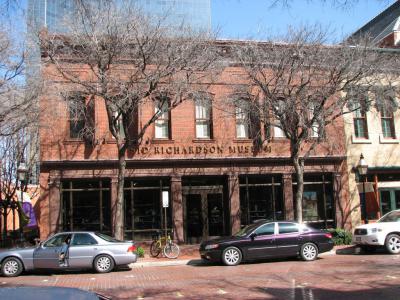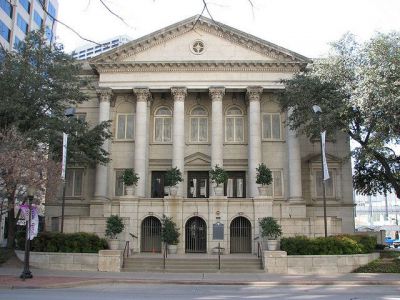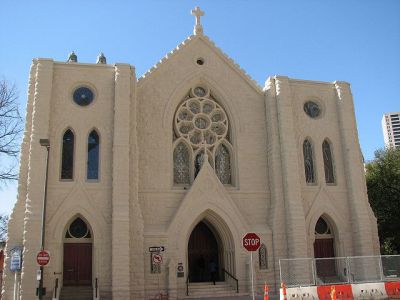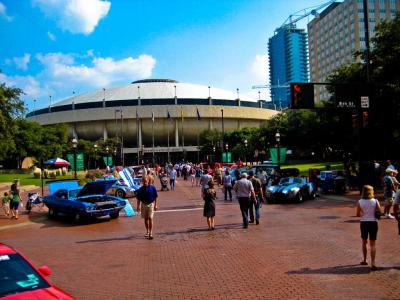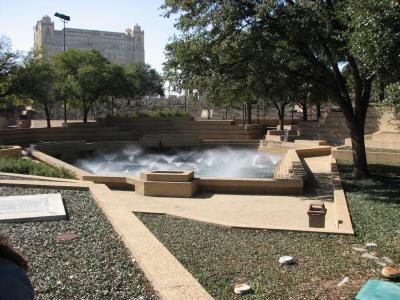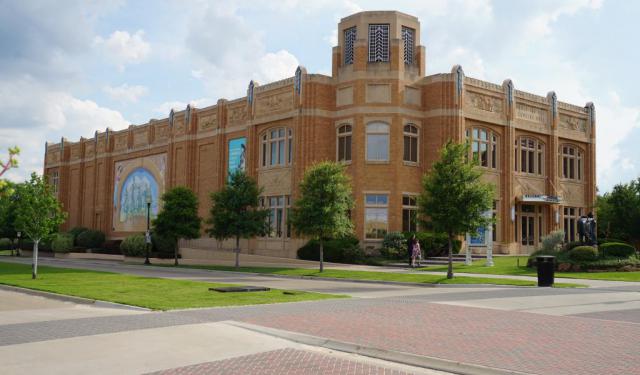Fort Worth Introduction Walk (Self Guided), Fort Worth
At over 900,000 people in the city proper and more than 7 million in the metro area, Fort Worth is one of the largest cities in the country. This now booming metropolis had a surprisingly meager start less than 200 years ago.
The history of Fort Worth began in 1849 with the establishment of a fort to protect the frontier after the Mexican-American War. Fort Worth was just one fortification in a succession of forts proposed by Major General William Jenkins Worth. The fort was abandoned only four years later. Nevertheless, the area became a popular stop along the Chisholm Trail.
As the epicenter of the cattle drives, Fort Worth grew around the cattle industry. That is still evident today with the popularity of the Stockyards and the twice-daily cattle drive. However, there is more to the city than ranching and the Wild West.
Sundance Square is one of the most visited spots in the city. This is the place to go for shopping, dining, entertainment and access to historic buildings. Some of the unique stops in and near Sundance Square include the Knights of Pythias Building, the Sid Richardson Museum and Fort Worth Water Gardens.
Visit these places and many more as you take this self-guided walking tour of Fort Worth, Texas.
The history of Fort Worth began in 1849 with the establishment of a fort to protect the frontier after the Mexican-American War. Fort Worth was just one fortification in a succession of forts proposed by Major General William Jenkins Worth. The fort was abandoned only four years later. Nevertheless, the area became a popular stop along the Chisholm Trail.
As the epicenter of the cattle drives, Fort Worth grew around the cattle industry. That is still evident today with the popularity of the Stockyards and the twice-daily cattle drive. However, there is more to the city than ranching and the Wild West.
Sundance Square is one of the most visited spots in the city. This is the place to go for shopping, dining, entertainment and access to historic buildings. Some of the unique stops in and near Sundance Square include the Knights of Pythias Building, the Sid Richardson Museum and Fort Worth Water Gardens.
Visit these places and many more as you take this self-guided walking tour of Fort Worth, Texas.
How it works: Download the app "GPSmyCity: Walks in 1K+ Cities" from Apple App Store or Google Play Store to your mobile phone or tablet. The app turns your mobile device into a personal tour guide and its built-in GPS navigation functions guide you from one tour stop to next. The app works offline, so no data plan is needed when traveling abroad.
Fort Worth Introduction Walk Map
Guide Name: Fort Worth Introduction Walk
Guide Location: USA » Fort Worth (See other walking tours in Fort Worth)
Guide Type: Self-guided Walking Tour (Sightseeing)
# of Attractions: 7
Tour Duration: 1 Hour(s)
Travel Distance: 1.5 Km or 0.9 Miles
Author: ChristineR
Sight(s) Featured in This Guide:
Guide Location: USA » Fort Worth (See other walking tours in Fort Worth)
Guide Type: Self-guided Walking Tour (Sightseeing)
# of Attractions: 7
Tour Duration: 1 Hour(s)
Travel Distance: 1.5 Km or 0.9 Miles
Author: ChristineR
Sight(s) Featured in This Guide:
- Sundance Square
- Knights of Pythias Building
- Sid Richardson Museum
- First Christian Church
- St. Patrick Cathedral
- Fort Worth Convention Center
- Fort Worth Water Gardens
1) Sundance Square (must see)
Sundance Square is a busy and bustling district located in downtown Forth Worth. It is a popular place for tourists because of ample entertainment, shopping, food and nightlife. It gets its name from Butch Cassidy's sidekick, the Sundance Kid. The two, along with their gang, would spend time in the area as they were evading the law.
Shoppers at Sundance Square will find more than a dozen unique boutiques to patronize. These shops sell clothing, jewelry, accessories, food items, tobacco and art. After perusing the shops, hungry tourists can find a restaurant that is guaranteed to please. Chain restaurants and local flavors are spread through Sundance Square.
There is no shortage of entertainment in this district. Sundance Square is the home of Bass Performance Hall, which offers concerts and theatre performances. Other entertainment venues include a jazz hall, comedy clubs, a movie theatre and a cigar bar, among others.
History lovers will enjoy seeing the former downtown Woolworth's Building, the Knights of Pythias Building and the Burk Burnett Building. All of these sites are listed on the National Register of Historic Places.
Shoppers at Sundance Square will find more than a dozen unique boutiques to patronize. These shops sell clothing, jewelry, accessories, food items, tobacco and art. After perusing the shops, hungry tourists can find a restaurant that is guaranteed to please. Chain restaurants and local flavors are spread through Sundance Square.
There is no shortage of entertainment in this district. Sundance Square is the home of Bass Performance Hall, which offers concerts and theatre performances. Other entertainment venues include a jazz hall, comedy clubs, a movie theatre and a cigar bar, among others.
History lovers will enjoy seeing the former downtown Woolworth's Building, the Knights of Pythias Building and the Burk Burnett Building. All of these sites are listed on the National Register of Historic Places.
2) Knights of Pythias Building
The Knights of Pythias Building, also referred to as the Knights of Pythias Castle Hall, is a historic building in downtown Forth Worth. Located in Sundance Square, the building is a Recorded Texas Historic Landmark. It also holds a spot on the National Register of Historic Places.
The first Pythian Castle Hall was built on this site in 1881. After it burned, the current redbrick building was erected in 1901. This building was the site of Fort Worth's first coin-operated laundry and the first offset printing press.
The Knights of Pythias is a fraternal organization that was founded in 1864. Though membership has considerably waned, it once had nearly one million members throughout the world. Notable knights have included Louis Armstrong, Nelson Rockefeller and Franklin D. Roosevelt.
Visitors are welcome to explore the Knights of Pythias Building as its lower floor has been converted into a retail space. From the outside, visitors can take note of the Pythian knight that overlooks Main Street.
The first Pythian Castle Hall was built on this site in 1881. After it burned, the current redbrick building was erected in 1901. This building was the site of Fort Worth's first coin-operated laundry and the first offset printing press.
The Knights of Pythias is a fraternal organization that was founded in 1864. Though membership has considerably waned, it once had nearly one million members throughout the world. Notable knights have included Louis Armstrong, Nelson Rockefeller and Franklin D. Roosevelt.
Visitors are welcome to explore the Knights of Pythias Building as its lower floor has been converted into a retail space. From the outside, visitors can take note of the Pythian knight that overlooks Main Street.
3) Sid Richardson Museum
The Sid Richardson Museum, located in Sundance Square, is a museum that offers pieces celebrating artists from the American West. The collection largely came from oil baron and art collector Sid Williams Richardson.
The permanent exhibitions have paintings by Frederic Remington, Charles M. Russell, Oscar E. Berninghaus, Charles F. Browne, William Gilbert Gaul, Peter Moran and others. Temporary exhibits continue to focus on the art of the American West by concentrating on a specific medium or topic.
In addition to the exhibitions, the Sid Richardson Museum offers special programs for children and adults. Visitors can register for art lectures, book talks or workshops to expand their art knowledge and/or skills.
The museum was constructed in 1982. It was designed to reflect the style of building that was popular in Fort Worth during the turn of the 20th century. The Sid Richardson Foundation conducted the mission to locate the site, construct the building and establish the museum.
You can visit the museum Monday - Thursday 10 AM - 5 PM | Friday 10 AM - 8 PM| Saturday 10 AM - 5 PM | Sunday 12 PM - 5 PM.
The permanent exhibitions have paintings by Frederic Remington, Charles M. Russell, Oscar E. Berninghaus, Charles F. Browne, William Gilbert Gaul, Peter Moran and others. Temporary exhibits continue to focus on the art of the American West by concentrating on a specific medium or topic.
In addition to the exhibitions, the Sid Richardson Museum offers special programs for children and adults. Visitors can register for art lectures, book talks or workshops to expand their art knowledge and/or skills.
The museum was constructed in 1982. It was designed to reflect the style of building that was popular in Fort Worth during the turn of the 20th century. The Sid Richardson Foundation conducted the mission to locate the site, construct the building and establish the museum.
You can visit the museum Monday - Thursday 10 AM - 5 PM | Friday 10 AM - 8 PM| Saturday 10 AM - 5 PM | Sunday 12 PM - 5 PM.
4) First Christian Church
The First Christian Church of Fort Worth is a historic church in the Sundance Square district. The church was built in 1915 and designed by architects E.W. Van Slyke and Clyde Woodruff. The architects chose a Beaux Arts and Renaissance Revival style for the design.
The church was founded in 1855. It is the oldest continuously operating church in the city. Originally, the congregation met in the home of a local doctor. It then moved to a masonic building before the rock structure was erected at the site of the current church.
Visitors will find that the limestone building has a Greek Cross plan, meaning it has a square central mass with four arms. It also has a copper dome and Corinthian columns. The building was given the Forth Worth Historical and Cultural Landmarks designation. It is also on the National Register of Historic Places.
Visitors are welcome to attend Sunday worship at 10:50 AM. Inside the church, parishioners will find a wood carving of Da Vinci's "The Last Supper" and an interior view of the stained glass cupola.
The church was founded in 1855. It is the oldest continuously operating church in the city. Originally, the congregation met in the home of a local doctor. It then moved to a masonic building before the rock structure was erected at the site of the current church.
Visitors will find that the limestone building has a Greek Cross plan, meaning it has a square central mass with four arms. It also has a copper dome and Corinthian columns. The building was given the Forth Worth Historical and Cultural Landmarks designation. It is also on the National Register of Historic Places.
Visitors are welcome to attend Sunday worship at 10:50 AM. Inside the church, parishioners will find a wood carving of Da Vinci's "The Last Supper" and an interior view of the stained glass cupola.
5) St. Patrick Cathedral
Saint Patrick Cathedral in Forth Worth is a Catholic Church and a Recorded Texas Historic Landmark. As a parish of the Diocese of Fort Worth, Saint Patrick Cathedral is the seat of the bishop. Construction on the building began in 1888 and completed in 1892. It was designed by architect James J. Kane in the Second Empire, Gothic Revival and Prairie architectural styles.
Visitors to Saint Patrick Cathedral will find that it is easy walking distance from Sundance Square. It is located at the corner of 12th and Throckmorton Streets in the heart of downtown Fort Worth. The Saint Patrick Cathedral Pastoral Center is located directly across 12th Street from the cathedral itself.
The church is open for mass on Sundays at 9:30 AM, 11 AM, 12:30 PM and 5 PM. Services at 8 AM are reserved for senior citizens. There is a 2:30 PM mass delivered in Spanish that is open to all. Daily mass takes place at 12:05 on Monday through Friday. Saturday mass is at 8 AM.
Saint Patrick Cathedral was named on the National Register of Historic Places in 1985.
Visitors to Saint Patrick Cathedral will find that it is easy walking distance from Sundance Square. It is located at the corner of 12th and Throckmorton Streets in the heart of downtown Fort Worth. The Saint Patrick Cathedral Pastoral Center is located directly across 12th Street from the cathedral itself.
The church is open for mass on Sundays at 9:30 AM, 11 AM, 12:30 PM and 5 PM. Services at 8 AM are reserved for senior citizens. There is a 2:30 PM mass delivered in Spanish that is open to all. Daily mass takes place at 12:05 on Monday through Friday. Saturday mass is at 8 AM.
Saint Patrick Cathedral was named on the National Register of Historic Places in 1985.
6) Fort Worth Convention Center
The Fort Worth Convention Center is an arena and convention center in Sundance Square. The space is used for sporting events, concerts, political rallies and, of course, conventions. It opened in 1968 as the Tarrant County Convention Center.
The convention center encompasses more than 14 city blocks. It was built on an area called "Hell's Half Acre," which was a red-light district in the 1870s. The buildings that once held bordellos and saloons were demolished to make way for the convention center.
The center has grown significantly over the years. It was expanded three times: in 1983, 2002 and 2003. It now consists of 253,226 square feet of exhibit space, a 28,160 square-foot ballroom, the arena and a connection to the Fort Worth Water Gardens, located next door.
Visitors to Fort Worth should stop by the flying saucer-shaped convention center to see the unique architecture. Those wishing to attend an event can check the convention center website for upcoming shows and conventions.
The convention center encompasses more than 14 city blocks. It was built on an area called "Hell's Half Acre," which was a red-light district in the 1870s. The buildings that once held bordellos and saloons were demolished to make way for the convention center.
The center has grown significantly over the years. It was expanded three times: in 1983, 2002 and 2003. It now consists of 253,226 square feet of exhibit space, a 28,160 square-foot ballroom, the arena and a connection to the Fort Worth Water Gardens, located next door.
Visitors to Fort Worth should stop by the flying saucer-shaped convention center to see the unique architecture. Those wishing to attend an event can check the convention center website for upcoming shows and conventions.
7) Fort Worth Water Gardens (must see)
The Fort Worth Water Gardens is an urban park located in downtown Fort Worth. It was built in 1974 from a design by architects Philip Johnson and John Burgee. It is comprised of three pools of water, sitting areas and shade trees. It is a popular place for visitors and locals to stop and cool themselves in a tranquil location.
The primary attraction is the active pool, which has water cascading down 38-feet of steps to a small pool. Visitors are welcome to walk up and down the steps as they please. It is a good way to cool off from the heat of the Texas sun.
The other two pools are the meditation pool and the aerating pool. The meditation pool, known as the quiet pool, is a steep walk down a flight of stairs where the sound of the city is removed and replaced by trickling water. The aerating pool includes illuminated spray fountains, which are popular with children of all ages.
The 4.3 acre water park has been used in Hollywood films and music videos. The design makes the water gardens very popular with professional and amateur photographers. It often falls on lists of the most instagrammable places in Fort Worth.
The Fort Worth Water Gardens are located adjacent to the Fort Worth Convention Center. They are conveniently located near a number of points of interest like the historic St. Patrick Cathedral and the bustling downtown district of Sundance Square.
The park is open seven days a week from 7 AM through 10 PM.
The primary attraction is the active pool, which has water cascading down 38-feet of steps to a small pool. Visitors are welcome to walk up and down the steps as they please. It is a good way to cool off from the heat of the Texas sun.
The other two pools are the meditation pool and the aerating pool. The meditation pool, known as the quiet pool, is a steep walk down a flight of stairs where the sound of the city is removed and replaced by trickling water. The aerating pool includes illuminated spray fountains, which are popular with children of all ages.
The 4.3 acre water park has been used in Hollywood films and music videos. The design makes the water gardens very popular with professional and amateur photographers. It often falls on lists of the most instagrammable places in Fort Worth.
The Fort Worth Water Gardens are located adjacent to the Fort Worth Convention Center. They are conveniently located near a number of points of interest like the historic St. Patrick Cathedral and the bustling downtown district of Sundance Square.
The park is open seven days a week from 7 AM through 10 PM.
Walking Tours in Fort Worth, Texas
Create Your Own Walk in Fort Worth
Creating your own self-guided walk in Fort Worth is easy and fun. Choose the city attractions that you want to see and a walk route map will be created just for you. You can even set your hotel as the start point of the walk.
Cultural District Walking Tour
Just minutes away from the hustle and bustle of the downtown's daily commerce, the Fort Worth Cultural District is a true gem deep in the heart of the city. Bordered by a tree lined boulevard paved with bricks and surrounded by manicured grounds, the area is alive with charming shops and restaurants.
But most importantly, the district is a home to the five prominent museums, such as the... view more
Tour Duration: 2 Hour(s)
Travel Distance: 3.5 Km or 2.2 Miles
But most importantly, the district is a home to the five prominent museums, such as the... view more
Tour Duration: 2 Hour(s)
Travel Distance: 3.5 Km or 2.2 Miles
Stockyards Cowtown Walking Tour
Once a major livestock center and a home to cowboys, cattlemen and outlaws, Fort Worth, TX has fully lived up to its nickname – “Cowtown.” From the late 1870s through the mid 1980s, the Fort Worth Stockyards made the city famous, drawing cattle from all over the state. Today mainly inactive, the Stockyards – "the last standing stockyards in the United States" – celebrates Fort... view more
Tour Duration: 1 Hour(s)
Travel Distance: 0.8 Km or 0.5 Miles
Tour Duration: 1 Hour(s)
Travel Distance: 0.8 Km or 0.5 Miles
Fort Worth Historical Buildings
Among the many ways to explore the richness of heritage fabric in Fort Worth there is one by historical architecture. Back in the 1920s-30s, the majority of Fort Worth’s notable buildings were designed by either Sanguinet & Staats or Wyatt Hedrick.
The former, in particular, were responsible for creating, among other structures, the Flatiron – one of the first high-risers in Fort Worth.... view more
Tour Duration: 2 Hour(s)
Travel Distance: 3.5 Km or 2.2 Miles
The former, in particular, were responsible for creating, among other structures, the Flatiron – one of the first high-risers in Fort Worth.... view more
Tour Duration: 2 Hour(s)
Travel Distance: 3.5 Km or 2.2 Miles
The Most Popular Cities
/ view all
